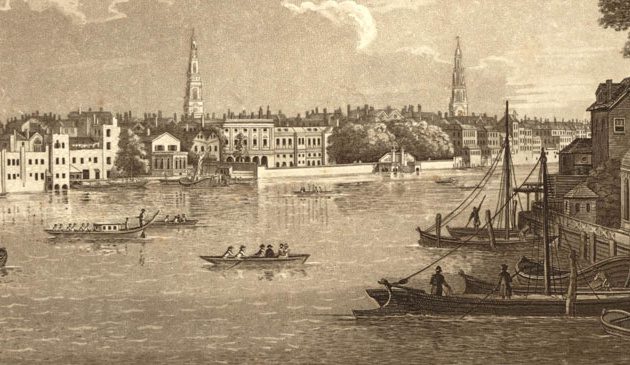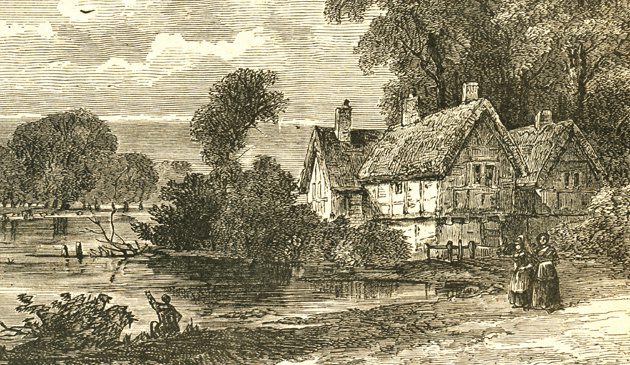Huguenots

In his painting and subsequent print The Four Times of Day: Noon (a detail shown here), created in 1738, William Hogarth contrasted the prosperous, smartly-dressed and sober Huguenot churchgoers with the more chaotic group of English outside the tavern on the opposite side of the street. The full version of the print has the steeple of St. Giles-in-the-Fields in the background, indicating that the location is Soho. Hogarth was well-acquainted with the diligence and skilfulness of Huguenot craftsmen in the area.
Spitalfields’ silk-weaving and the associated trades eventually went into decline, due to the complexity of its production and subsequent high cost. In the early 18th century new, cheaper fabrics were being imported by the East India Company. In June 1719 4,000 Spitalfields weavers went on the rampage in the City, attacking calico printing works and women wearing imported Indian fabrics. The Lord Mayor called out the City’s trained bands and Horse Grenadiers. In the next few years laws were introduced to reduce the importation of cotton to protect the local silk weavers.
Paradoxically, during the mid-18th century many Catholic Irish, persecuted in their homeland by the Protestant government, came to London where they were subject to fewer restrictions. Many had previously worked in the Irish linen industry and found employment as Spitalfields silk-weavers where they were prepared to work at lower rates than the settled Huguenots. There were thereafter periodic disputes between the workers and their employers over wages, protests, and even riots.
After the ending of the Seven Years War in 1763 silks once again began to be imported from France. Following pressure from British weavers the government imposed high import duties on French silks but that only created widespread smuggling. Various Acts of Parliament were passed from 1773. The ‘Spitalfields Acts’, suggested to London’s weavers by the magistrate Sir John Fielding, were designed to protect the wages of journeymen weavers throughout Middlesex by fixing prices but led to their employers moving to the north of England and Scotland. The Acts were repealed in 1824. At that time there were about 20,000 handlooms in use in Spitalfields. Yet, in 1838 that had reduced by half, the majority of which were in Bethnal Green. By then many of the weavers were destitute, particularly because the Industrial Revolution had brought mechanisation that rendered their skills unnecessary. The new power-loom machines used in Northern mills were too big and heavy to fit into the small home-workshops of East London.
Various Huguenots and their descendants left their mark in industry and finance. Seven of the original directors of the Bank of England were of Huguenot descent, including the first governor, Sir John Houblon. He also served as Lord Mayor of London and Lord of the Admiralty. His image was on English £50 notes during the 1990s. In 1724 the Bank of England awarded the contract to produce high-quality banknotes to Laverstoke Mill in Hampshire, owned by Henry Portal of Huguenot descent. The following year Henry was able to include a watermark into the paper to make it difficult to counterfeit. The banknote contract was retained for 270 years when the company was acquired by Haverstock Mill and its later parent, De La Rue, who continue to specialise in banknotes and security printing.
Philip Cazenove founded Casanove & Co., which by the 20th century had become one of London’s leading stock-broking firms and now is part of J.P. Morgan. The broker John Castaing was the instigator of the twice-weekly Course of the Exchange at Jonathan’s coffee house, which is still published as the Stock Exchange Daily List. George Courtauld founded his business at Spitalfields in the 18th century and in the 20th century it was Britain’s leading manufacturer of synthetic fabrics. Jean Rocque began selling maps in Great Windmill Street, Soho. The first map he produced was in 1734. He then began mapping London, producing 24 highly detailed and accurate maps, which remain as a fascinating record of the mid-18th century capital. In 1750 he was appointed topographer to the Prince of Wales. The original Westminster Bridge was designed by the Swiss-born expert in land-drainage Charles Labelye, with the help of a pile-driver fellow Huguenot James Vauloué. Sir John Romilly, of Huguenot descent, became Attorney General and then Master of the Rolls. It was due to his campaigning that the National Archives at Kew came into being.
There were distinguished Huguenots in the field of medicine. Dr. Andrée was one of the founders of the London Hospital at Whitechapel and Colonel Peter Lekeux served as a governor. William Chamberlen and his family, who fled to England in 1569, were the inventors of forceps used in childbirth. Peter Chamberlen was appointed surgeon to Queen Henrietta Maria, wife of Charles I. Hugh Chamberlen was the author of the first textbook on midwifery in 1673. Sir Theodore de Mayerne was Chief Physician to both James I and Charles I and who in his case reports was one of the first to list all the physical signs of illnesses. Gideon de Laune was apothecary to Anne of Denmark, wife of James I, and successfully petitioned the King to incorporate the Company of Apothecaries by royal charter in 1617.
Several Huguenots became mathematicians, inventors and members of the distinguished Royal Society. Abraham de Moivre left the Champagne area of France in around 1685 and settled in St. Martin’s Lane. He worked with the astronomer Edmund Halley and became a friend of Sir Isaac Newton. It was he who created the formula for calculating life annuities and life assurances. Denis Papin, was born in Blois and arrived in England in 1675. While working for the chemist and physicist Robert Boyle he invented the pressure cooker and the first steam engine with a piston. James Six was made a Fellow of the Royal Society in recognition of his invention of the thermometer. John Theophilus Desaguliers became an assistant to Newton and designed and installed the first air-conditioning system for the House of Commons in 1723. He was also the first to create a machine to establish the exact distance between planets. The Spitalfields weaver John Dolland left Normandy and studied mathematics, optics and astronomy, for which he was awarded a medal by the Royal Society. His son Peter opened an optical workshop in Spitalfields in 1750 and created a popular telescope. The family continued in the optical business through the generations and in 1927 joined with the Aitchison company, the business continuing on Britain’s high streets as Dolland & Aitchison. The family of Peter Mark Roget settled in Edinburgh. He is the inventor of the slide-rule but is better-known for his Roget’s Thesaurus. Huguenots also brought with them culinary skills and new types of food such as oxtail soup and saveloys.
Designer Daniel Marot left Paris and followed William of Orange to England, where he undertook work at Hampton Court Palace. He also designed the royal state coach first used by Queen Anne and last used for a state occasion in 1981 during the wedding of Charles and Diana. There were Huguenot clock-makers working in England from the reign of Elizabeth I. As many as 670 of them and their families died in London during the plague of 1603 yet enough survived to form the Worshipful Company of Clockmakers in 1631. Other Huguenot trades of note included furniture-making, engraving, architecture, wood-carving, ceramics and glass-making. Jean Tijou produced the grillwork for Sir Christopher Wren’s design of St. Paul’s Cathedral, which can still be seen there today. Paul de Lamerie was appointed gold- and silversmith to George I. In the late 1720s and early 1730s he employed William Hogarth as an engraver who was then just beginning to establish himself as an artist. Joseph Bazalgette, who created London’s sewer system during the Victorian era, was the grandson of a Protestant immigrant. Many well-known talents of British stage, screen and music are descendants of Huguenots, from David Garrick in the 18th century to Laurence Olivier, Jon Pertwee, Derek Jacobi, Eddie Izzard and Simon Le Bon in more recent times.
Sources include: Joyce Hampton, The Story of the Huguenots; Dan Cruickshank, Spitalfields; Sir Hubert Llewellyn Smith, The History of East London (1939); www.spitalfieldslife.com


